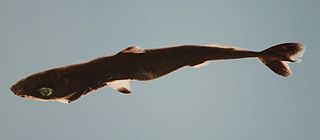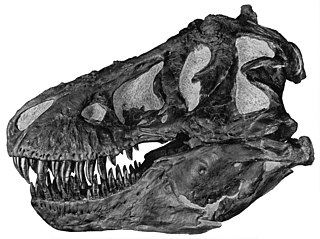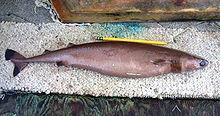
Dolphin is a common name of aquatic mammals within the infraorder Cetacea. The term dolphin usually refers to the extant families Delphinidae, Platanistidae, Iniidae, and Pontoporiidae, and the extinct Lipotidae. There are 40 extant species named as dolphins.

Sharks are a group of elasmobranch fish characterized by a cartilaginous skeleton, five to seven gill slits on the sides of the head, and pectoral fins that are not fused to the head. Modern sharks are classified within the clade Selachimorpha and are the sister group to the rays. However, the term "shark" has also been used for extinct members of the subclass Elasmobranchii outside the Selachimorpha, such as Cladoselache and Xenacanthus, as well as other Chondrichthyes such as the holocephalid eugenedontidans.

The great white shark, also known as the great white, white shark or white pointer, is a species of large mackerel shark which can be found in the coastal surface waters of all the major oceans. The great white shark is notable for its size, with larger female individuals growing to 6.1 m (20 ft) in length and 1,905 kg (4,200 lb) in weight at maturity. However, most are smaller; males measure 3.4 to 4.0 m, and females measure 4.6 to 4.9 m on average. According to a 2014 study, the lifespan of great white sharks is estimated to be as long as 70 years or more, well above previous estimates, making it one of the longest lived cartilaginous fish currently known. According to the same study, male great white sharks take 26 years to reach sexual maturity, while the females take 33 years to be ready to produce offspring. Great white sharks can swim at speeds of over 56 km/h (35 mph), and can swim to depths of 1,200 m (3,900 ft).

The tiger shark is a species of requiem shark and the only extant member of the genus Galeocerdo. It is a large macropredator, capable of attaining a length over 5 m. Populations are found in many tropical and temperate waters, especially around central Pacific islands. Its name derives from the dark stripes down its body, which resemble a tiger's pattern, but fade as the shark matures.

Stejneger's beaked whale, also known as the Bering Sea beaked whale or the saber-toothed whale, is a relatively unknown member of the genus Mesoplodon inhabiting the northern North Pacific Ocean. Leonhard Hess Stejneger collected the type specimen on Bering Island in 1883, from which Frederick W. True provided the species' description in 1885. In 1904, the first complete skull was collected, which confirmed the species' validity. The most noteworthy characteristic of the males is the very large, saber-like teeth, hence the name.

Megalodon, meaning "big tooth", is an extinct species of shark that lived approximately 23 to 3.6 million years ago (mya), during the Early Miocene to the Pliocene. It was formerly thought to be a member of the family Lamnidae, making it closely related to the great white shark. However, presently there is near unanimous consensus that it belongs to the extinct family Otodontidae, which diverged from the ancestry of the great white shark during the Early Cretaceous. Its genus placement is still debated, authors placing it in either Carcharocles, Megaselachus, Otodus, or Procarcharodon.

The dusky smooth-hound, also called the smooth dogfish or the dog shark, is a species of houndshark in the family Triakidae. This shark is an olive grey or brown in color, and may have shades of yellow or grayish white. Females live to 16 years and males have a lifespan of 10 years. M. canis was the first shark recognised to have viral infections.

The kitefin shark or seal shark is a species of squaliform shark in the family Dalatiidae, and the only species in its genus. It is found sporadically around the world, usually close to the sea floor at depths of 200–600 m (660–1,970 ft). With a sizable oil-filled liver to maintain neutral buoyancy, this shark is able to cruise slowly through the water while expending little energy. The kitefin shark has a slender body with a very short, blunt snout, large eyes, and thick lips. Its teeth are highly differentiated between the upper and lower jaws, with the upper teeth small and narrow and the lower teeth large, triangular, and serrated. Its typical length is 1.0–1.4 m (3.3–4.6 ft).

The horn shark is a species of bullhead shark, in the family Heterodontidae. It is endemic to the coastal waters off the western coast of North America, from California to the Gulf of California. Young sharks are segregated spatially from the adults, with the former preferring deeper sandy flats and the latter preferring shallower rocky reefs or algal beds. A small species typically measuring 1 m (3.3 ft) in length, the horn shark can be recognized by a short, blunt head with ridges over its eyes, two high dorsal fins with large spines, and a brown or gray coloration with many small dark spots.

The smalltooth sand tiger or bumpytail ragged-tooth is a species of mackerel shark in the family Odontaspididae, with a patchy but worldwide distribution in tropical and warm temperate waters. They usually inhabit deepwater rocky habitats, though they are occasionally encountered in shallow water, and have been known to return to the same location year after year. This rare species is often mistaken for the much more common grey nurse shark, from which it can be distinguished by its first dorsal fin, which is larger than the second and placed further forward. It grows to at least 4.1 m (13.5 ft) in length.

The crocodile shark is a species of mackerel shark and the only extant member of the family Pseudocarchariidae. A specialized inhabitant of the mesopelagic zone, the crocodile shark can be found worldwide in tropical waters from the surface to a depth of 590 m (1,940 ft). It performs a diel vertical migration, staying below a depth of 200 m (660 ft) during the day and ascending into shallower water at night to feed. Typically measuring only 1 m (3.3 ft) in length, the crocodile shark is the smallest living mackerel shark. It can be distinguished by its elongated cigar-shaped body, extremely large eyes, and relatively small fins.

The largetooth cookiecutter shark is a rare species of squaliform shark in the family Dalatiidae, reported from depths of 60–200 m (200–660 ft) at scattered locations in the Atlantic and Pacific Oceans. As its common name suggests, it is similar in appearance to the cookiecutter shark but has much larger lower teeth. Most individuals also lack the dark "collar" of I. brasiliensis. This species reaches a maximum known length of 42 cm (17 in). The largetooth cookiecutter shark feeds by gouging out chunks of flesh from larger animals, including bony fishes, sharks, and marine mammals, and is able to take larger bites than I. brasiliensis. Little is known of its life history; it is thought to be a weaker swimmer than I. brasiliensis, and is presumably aplacental viviparous like the rest of its family. This shark is an infrequent bycatch of commercial trawl and longline fisheries, but is not thought to be much threatened by these activities.

The spined pygmy shark is a species of squaliform shark in the family Dalatiidae found widely in all oceans. Growing no larger than roughly 28 cm (11 in), it is one of the smallest sharks alive, with this record beaten by the dwarf lanternshark. This shark has a slender, cigar-shaped body with a sizable conical snout, a long but low second dorsal fin, and an almost symmetrical caudal fin. Its sister species S. aliae and it are the only sharks with a spine on the first dorsal fin and not the second. Spined pygmy sharks are dark brown to black, with numerous bioluminescent organs called photophores on their ventral surface. The shark is believed to use these photophores to match ambient light conditions, which break up its silhouette and help the shark to avoid being seen by predators below.

A shark tooth is one of the numerous teeth of a shark. A shark tooth contains resistant calcium phosphate materials. Sharks continually shed their teeth; some Carcharhiniformes shed approximately 35,000 teeth in a lifetime, replacing those that fall out. There are four basic types of shark teeth: dense flattened, needle-like, pointed lower with triangular upper, and non-functional. The type of tooth that a shark has depends on its diet and feeding habits.
Durophagy is the eating behavior of animals that consume hard-shelled or exoskeleton bearing organisms, such as corals, shelled mollusks, or crabs. It is mostly used to describe fish, but is also used when describing reptiles, including fossil turtles, placodonts and invertebrates, as well as "bone-crushing" mammalian carnivores such as hyenas. Durophagy requires special adaptions, such as blunt, strong teeth and a heavy jaw. Bite force is necessary to overcome the physical constraints of consuming more durable prey and gain a competitive advantage over other organisms by gaining access to more diverse or exclusive food resources earlier in life. Those with greater bite forces require less time to consume certain prey items as a greater bite force can increase the net rate of energy intake when foraging and enhance fitness in durophagous species. In the order Carnivora there are two dietary categories of durophagy; bonecrackers and bamboo eaters. Bonecrackers are exemplified by hyenas and saber-toothed cats, while bamboo eaters are primarily the giant panda and the red panda. Both have developed similar cranial morphology. However, the mandible morphology reveals more about their dietary resources. Both have a raised and dome-like anterior cranium, enlarged areas for the attachment of masticatory muscles, enlarged premolars, and reinforced tooth enamel. Bamboo eaters tend to have larger mandibles, while bonecrackers have more sophisticated premolars.
S. brasiliensis may refer to:

Livyatan is an extinct genus of sperm whale containing one species: L. melvillei. The genus name was inspired by the biblical sea monster Leviathan, and the species name by Herman Melville, the author of the famous book Moby-Dick about an albino bull sperm whale. It was found in the Pisco Formation of Peru and lived during the Tortonian stage of the Miocene epoch, about 9.9–8.9 million years ago (mya); however, a large tooth from Australia implies that either it or a close relative survived into the Pliocene, around 5 mya. It was a member of a group of hyper-predatory macroraptorial sperm whales and was likely an apex predator, preying on whales, seals, and so forth. Characteristic of raptorial sperm whales, Livyatan had functional, enamel-coated teeth on the upper and lower jaws, as well as several adaptations for hunting large prey.

Most bony fishes have two sets of jaws made mainly of bone. The primary oral jaws open and close the mouth, and a second set of pharyngeal jaws are positioned at the back of the throat. The oral jaws are used to capture and manipulate prey by biting and crushing. The pharyngeal jaws, so-called because they are positioned within the pharynx, are used to further process the food and move it from the mouth to the stomach.

Biting is a common behavior which involves the opening and closing of the jaw found in many animals. This behavior is found in reptiles, mammals, fish and amphibians. Arthropods can also bite. Biting is a physical action in an attack but it is also a normal activity or response in an animal as it eats, carries objects, softens and prepares food for its young, removes ectoparasites from its body surface, removes plant seeds attached to its fur or hair, scratching itself, and grooming other animals and for defense. Animal bites often result in serious infections and death. Dog bites are commonplace, with human children the most commonly bitten and the face being the most common target.





















